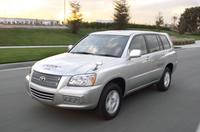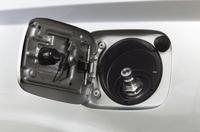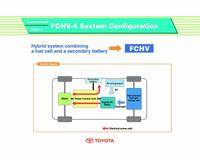Toyota Expands Its Real-World Testing of Fuel Cell Hydrogen Vehicles
SONOMA, Calif., Sept. 24 -- Toyota's commitment to gaining real-world experience for its Fuel Cell Hydrogen Vehicles (FCHV) took another step forward today when it was announced that two more vehicles would be put into action with the assistance of the University of California, Irvine and the University of California, Davis.
The FCHVs will be leased by UC Irvine's National Fuel Cell Research Center ( www.nfcrc.uci.edu ) and by UC Davis' Institute of Transportation Studies ( http://its.ucdavis.edu/ ). These will be the second Toyota fuel cell vehicles for each of the schools. Since the first wave of vehicles was announced in December 2002, the two FCHVs have logged nearly 6,000 miles.
The new FCHVs have been improved for U.S. use, including left-hand drive operation, improved braking performance and a new navigation system.
The addition of these vehicles will bring the total number of FCHVs on the road to 18. Four will be with the universities, three with the California Fuel Cell Partnership, one at Toyota Motor Sales, U.S.A., Inc. and 10 with Japanese government agencies and private companies.
"Fuel cell vehicles are widely hailed as the automotive technology of the future, but Toyota is taking the lead by getting hands-on experience today," said Jim Press, Toyota's chief operating officer. "The universities are playing a vital role by providing feedback and data that will help us evolve this technology for tomorrow's consumers."
Toyota's FCHVs are based on the Highlander mid-sized sport utility vehicle and contain a Toyota-developed proprietary fuel cell system with four 5,000-psi hydrogen fuel tanks. Hydrogen gas feeds into the fuel cell stack where it is combined with oxygen. This generates a peak of 90 KW of electricity that powers the 109-hp electric motor (194 lb-ft of torque) and charges the vehicle's nickel-metal hydride batteries which also feed power-on-demand to the electric motor. The only emission is clean water vapor.
By applying the hybrid technologies developed in the Toyota Prius gas-electric hybrid vehicle, the Toyota FCHV fuel cell electric system precisely regulates power flow from the fuel cell stack and battery to achieve high efficiency, excellent acceleration and a smooth quiet ride. The FCHV has a top speed of 96 mph. It has a lighter body shell than the Highlander, thanks to the use of aluminum in the roof, fenders and other components.
The FCHVs have a maximum range of about 180 miles, so the development of a hydrogen fueling infrastructure is critical to fuel cell vehicle success. Toyota has been working diligently with a variety of companies and agencies, including the California Air Resources Board (CARB), South Coast Air Quality District (SCAQMD), Air Products and Stuart Energy to establish fueling stations.
Toyota's commitment to real-world testing began in July 2001 in cooperation with the California Fuel Cell Partnership, a public-private venture dedicated to demonstrating fuel cell technology in California.
"We've come a long way in setting up this fuel cell community," said Press. "This isn't a science project for Toyota and for the universities -- it's a real test of the strengths and limitations of fuel cells. And, now that each school has twice as many fuel cell vehicles, we look forward to even more feedback on how to make this technology feasible for the future."
Toyota FCHV Main Specifications
Metric Units U.S. Units
Toyota FCHV
Dimensions L 4,735 mm 186 in.
Vehicle W 1,815 mm 71 in.
H 1,685 mm 66 in.
Weight 1,860 kg 4,092 lb.
Seating capacity 5 people 5 people
Performance Max cruising range 290 km 180 mi.
Maximum speed 155 km/h 96 mph
Fuel Cell Stack Name Toyota FC Stack
Type Polymer electrolyte fuel cell
Output 90 kW 122 hp
Motor Type Permanent Permanent
magnet magnet
Maximum output 80 kW 109 hp
109 PS --
Maximum torque 260 N-m 194 lb.-ft.
26.5 kg-m --
Fuel Type Pure hydrogen
Storage method High-pressure hydrogen
storage tanks
Max. storage pressure 35 MPa 5,000 psi
Secondary battery Type Nickel-metal hydride (NiMH)





